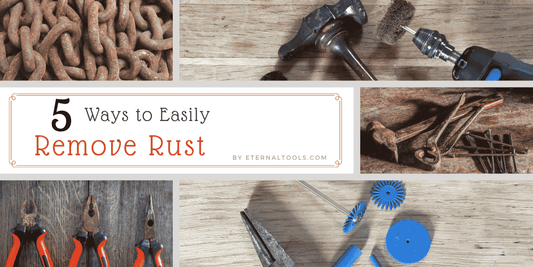What is Rust?
Rust is a type of corrosion that forms when iron, iron alloys, or steel react with oxygen and moisture. This process, known as oxidisation, results in a red-brown, flaky coating that weakens the metal over time.
Even in indoor settings, high humidity and temperature changes can cause rusting—so don't assume your jewellery tools are safe just because they're stored inside.
Do All Metals Rust?
No, not all metals rust. The term rust specifically applies to corrosion of iron, its alloys, and steel. Other metals can corrode or tarnish but not rust in the technical sense.
Rust vs Tarnish?
Rust affects iron-based metals, while tarnish appears on non-ferrous metals like copper and silver.
Copper is the common culprit in most things we see that have tarnished. The patina (greenish-coloured staining) is caused by the copper oxidising and results in a build-up of this tarnished layer.
Sterling silver in particular is made up of a mixture of metals including copper, which is why you sometimes find a ring of green colouring on your finger.
- Copper: Forms a greenish patina due to oxidation.
- Sterling Silver: Often tarnishes because it contains copper, which can leave green stains on skin.
Metals That Do Not Rust
The following metals don’t rust, though they may tarnish or corrode:
- Aluminium
- Brass
- Bronze
- Galvanised steel
- Stainless steel
- COR-TEN steel
- Copper
- Titanium
- Noble metals: Gold, Silver, Platinum
How to Remove Rust from Metal - 5 Quick Ways
There are numerous ways to remove rust, oxides, and corrosion from just about anything. Some methods use household cleaning products, aluminium foil, and acid, while others involve rotary tool attachments for fast and mess-free removal. Take a look at the list below for more details.
1. Fiberwheels – Abrasive Buff Wheels
- This is by far the quickest and most fuss-free method of removing rust from your metal items.
- Wear protective gear (goggles, face mask, etc).
- Attach a Brown (coarse) EVE Fiberwheel Abrasive Buff Wheel to a rotary tool like a Dremel, and set it to ~7,000 rpm.
- Gently move the abrasive across the metal—rust disappears in seconds.
- To restore the shine, follow up with the Black (medium) for pre-polish and the Red (fine) for a final polish.
See the before and after images, along with the short demo video:
2. Abrasive Rubber Polishers
- Equally as quick and mess-free as Fiberwheels are EVE rubber abrasive polishers.
- For fast rust removal from jewellery tools, use a 500 grit (Blue, very coarse) EVE Technic Polisher in your rotary tool.
- Choose your shape depending on the job:
- 3mm pin – tight corners
- radial bristle disc – intricate areas
- large cylinder – big surface areas
- small cylinder – precision work
- Use finer grits to bring back the mirror shine after rust removal.
See the before and after images, along with the short demo video:
3. Steel Brush Wheel or Aluminium Foil
A more traditional method:
- Aluminium foil: Dip in water or vinegar and rub over the rust.
- Steel brush: Use a Steel Brush Wheel or wire pen brush in your rotary tool.
These work well but may take longer than abrasive wheels or polishers.
4. Salt and Lemon Juice/Vinegar
- Sprinkle salt on the rusted area.
- Soak with lemon juice or vinegar.
- Let sit for a few hours, then scrub clean.
Tip: Some claim rubbing with a raw potato (which contains oxalic acid) also helps—but we haven’t tested this.
5. Baking Soda (Bicarbonate of Soda)
- The rusted item can either be dusted with baking soda or made into a paste with water or vinegar.
- Apply to the areas and leave for an hour or so then clean off with a brush.
- Mark Lovick from the Watch Repair Channel shows this method in his excellent video: Service and repair of a Rusty Valjoux 7750-based Breitling Watch. Take a look at the Youtube video here. He uses a mixed paste of soda and cleans off the watch parts with a toothbrush peg wood.
How to Prevent Rust
Prevention is key:
- Store tools in dry, non-humid environments.
- Regularly clean and oil them.
- Use protective coatings like:
- Bluing – common in watch and clock parts
- Powder coatings – acrylic, vinyl, epoxy
- Galvanizing – molten zinc coating
- Blackening – try natural Beeswax




